Let’s assume that you have an expert team working on your social media and digital marketing strategies. You are also getting traffic to your website and pages. However, the traffic isn’t converting into sales. Why is that? It might be because you are unable to keep your visitors hooked with your product descriptions.
Sometimes, an ecommerce business owner gets so caught up in the aesthetic looks of their products and their attractive web design that they completely ignore the value of product descriptions.
Now, according to this ecommerce study, 20% of website visitors do not convert because of unclear or incomplete product information. This is how they explained it,
One shopper in a recent study could not find the information he needed in the product description, so he left the site to search Google for more product information. In the course of his search, he found another site with the same product, a more complete description, and a lower price.
And, that is how you lose out on potential customers. So, today, we will talk about how to convince site visitors with product descriptions. If you think that a simple piece of content that describes the product will work, think again!
Read on to know about what differentiates a good product description from a bad one and how to write a description that stands out.
Good vs. Bad Product Descriptions
What do we consider a ‘bad’ product description? Anything that fails to explain your product to your target audience.
It has basically nothing to do with the length, images, or even the words that you may use. Or at least, they aren’t as important. The goal is to explain the product like, ‘what it does’ and ‘why you need it’.
Take a look at this Lululemon example:
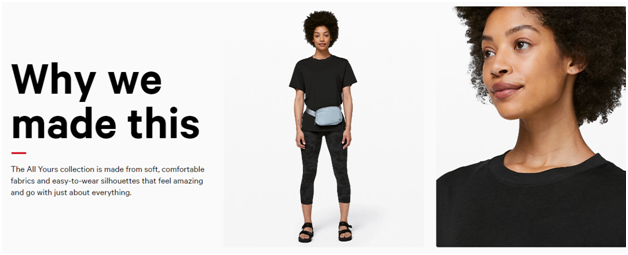
The product itself is self-explanatory and so it is okay to keep it simple. And that will work just fine as it is obvious what the product does and who it is for. In addition, the company explains the material as ‘soft, comfortable, and easy to wear’, giving you an overall idea of the tee.
The selling factors of this product depend on how it looks on the model (the image quality), color options, sizes, price, and availability. And therefore, even a small, sweet, and short description does the trick.
Now, let’s compare it with this SuperSnorkel example:
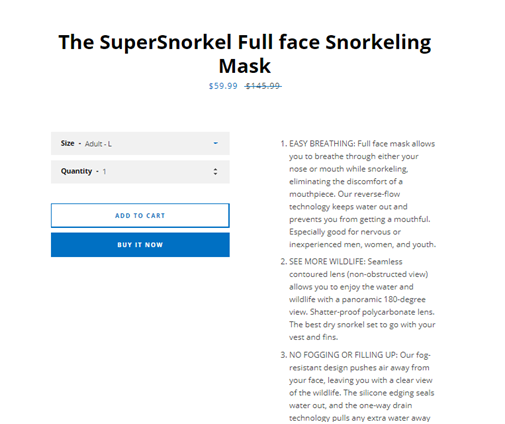
The product does not give away anything. The only thing one can guess is that ‘is it some kind of mask?’ And that’s where the product description helps you out.
The elaborate explanation of ‘what the product does, why it’s different (and better), and why you need it (for improving experience)’ has got the product covered.
So, when we compare these two product descriptions, we see that:
- A good description explains what the product does.
- It offers you benefits or added value.
- It includes all the information needed.
Now, take a look at this example from AND:
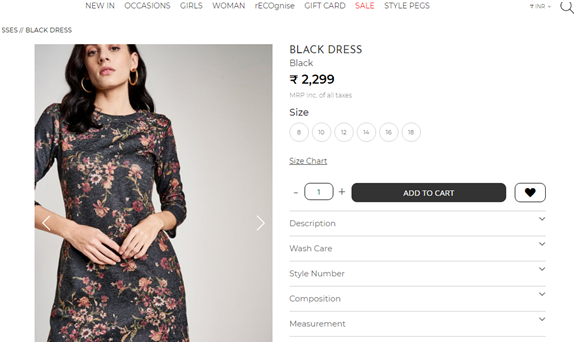
It is a beautiful dress from AND (a brand I prefer to wear), but their online product descriptions need work. For instance, the only description provided for the piece above is ‘A Black Dress’, (which I can definitely see myself, but thanks). In case I want to know if the dress has a shoulder lapel or shoulder closure pattern, or even a belt, I will be at a loss. Such inadequate descriptions can make a prospect decide to ‘never shop online from this website again’.
So, it’s vital to focus on writing smashing product descriptions. Here’s how you can go about it.
Tips for Writing Great Product Descriptions
1. Define the Buyer
If you are running an ecommerce store, you will have a specific type of target audience. Write to them. Use the language they use and tone they prefer.
For example, let’s take look at these two products,
Dope Taupe Pencil
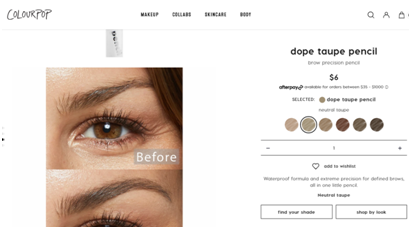
MacBook Air
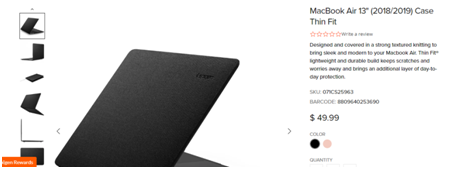
These products appeal to different audiences, and so, their tones and words are different.
The tone of your product description should vary according to the audience. You can go with:
- Feminine or manly
- Economical tone or a luxurious feel
- Classic stance or modern up-to-date beat
- Youthful or mature tone
- Playful or sophisticated
And so on…
This is where defining your target audience becomes a necessity as your content will speak to them. Here are some of the basic questions that will help you in identifying your ideal customer are:
- Who is this product for?
- Whose problems are you solving?
- Who needs your product the most?
- Who will benefit the most from your product?
- What language, words, phrases, and tone does your target audience like to use?
- Why would they like to buy from you rather than your competitors?
Use this buyer persona, and cultivate a strategy to write content that persuades and converts your website visitors.
2. Persuade Customers with Your USPs and Their Benefits
As an owner of a business or ecommerce store, you might be excited and interested in sharing your products’ features. But are your customers interested in knowing all of them? Probably not.
While your customers aren’t interested in the mundane features of your product, they want to know about the ones that can benefit them.
Let’s take the product description example of this Himalayan Pink Salt Glow Lamp:
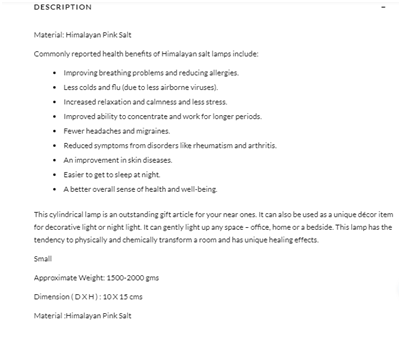
See how the company has mentioned the health benefits of the lamp as well as how one can use it as a décor item – thanks to the aesthetic looks. The company also mentions it as an item worthy of gifting to someone you care about. This way, it tells the customer everything they need to know about the product, right from the dimensions, colour, and looks, to benefits, making it more interesting for them.
Here are some suggestions that can help you highlight the features and benefits of your products:
- Encourage customers by focusing on what they will achieve with this product.
- Let customers visualise the idea of owning the product.
- Make the customer release that they need the product.
- Highlight the problem that you will be solving with this product.
- Tell your customers why your product is better than the competitor.
3. Bullet Points to The Rescue
We live in a fast-paced world. So, if your visitors can’t SKIM the information, they will just turn away.
No one has time to read long descriptive paragraphs. So, help them get the relevant information quickly by adding bullet points. Your visitors will skim through the bullet points and decide whether they need it or not in a matter of seconds. So, keep product descriptions simple and to-the-point.
Take an example of this decorative rock salt lamp:
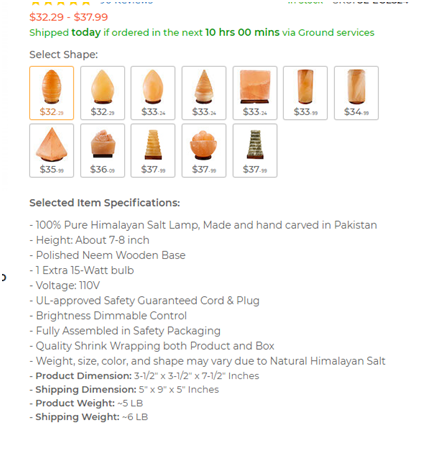
They have used bullets to list the features and technical aspects of the lamp for anyone who is in hurry or just comparing the data. For others, when you scroll down, you will find an in-depth description of what their product is, the benefits, packaging information, as well as a manual for installation. In short, it is a complete guide that satisfies the curiosity of their buyers and does not leave any questions unanswered.
Here is another example that I have taken from Amazon – it’s a flagship product called ‘Fire Stick’.
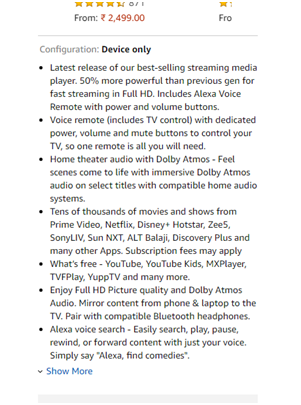
In the product description part, you can see that it has a lot of information. But it is still easy to skim through all of it. Just reading the first line of every bullet point is enough to get a decent idea about the item. It’s Amazon’s way of satisfying customers who have little time as well as those who are hungry for information.
So, know who your customers are and what they prefer, before you write a product description that attracts and converts them.
4. Play with Their Imagination
According to a scientific research paper, if people hold a product, they want to own the product more.
Now, the problem is that, you cannot actually let the visitor physically touch a product on a digital platform. So, what you can do is let them imagine it. Play with words and let their imagination do all the work.
A good example of this is the Gillette Mach3 Razor
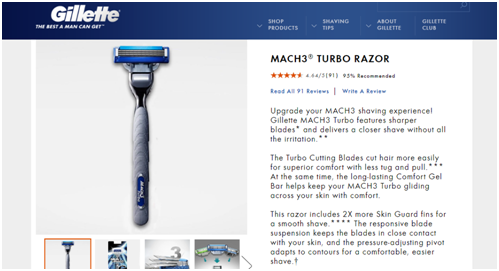
The familiar phrase used by the brand – ‘delivers a closer shave without all irritation’ – is something every man, who has ever tried shaving, appreciates. Furthermore, they describe the product as ‘cut hair more easily for superior comfort with less tug and pull’. This way, they address another common pain point of men who shave.
Let’s take look at another example of the Warm and Cosy candle by Yankee Candle:
The brand is an expert at evoking positive feelings with their product descriptions.
Now, with this candle, you actually don’t need any features or details. Their main selling point is how the candles and their fragrance make you feel. And, so, they describe it as,
A beautiful bonfire night ends wrapped up in a soft blanket as you breathe in crisp, fresh notes of cedar, cashmere, and eucalyptus.
It conjures such an enticing picture, right? It transports you to a happy place instantly! Naturally, any website visitor will feel compelled to buy.
5. Use Storytelling
Another method you can use is storytelling. But, only go with this if your target audience enjoys it and your brand tone complements the concept.
The J. Peterman Company excels in this type of product description:
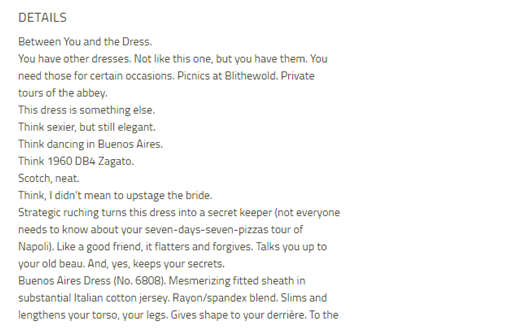
The company harps on the fact that though you might own many dresses in blue, you will still want to have this in your wardrobe. The theme and story behind this particular product is so enchanting. You can also check other products by The J. Peterman Company to get a hang of the concept of storytelling.
Another company that aces this concept is DrunkMall
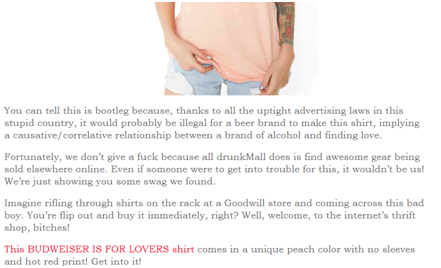
This website describes products that are available on another ecommerce website. But when you compare the product descriptions, this website definitely steals the show with their funky, sassy, and upbeat tone.
The company has identified its target audience and relies on its sassy, sarcastic approach to hook the customers. I definitely love to read their product descriptions (and at times end up buying a few unorthodox items too).
6. Use Specific and Interactive Language
I cannot stress much on how important language and tone play is, while writing product descriptions. Using specific, active, and descriptive tone makes the copy more believable and relatable. In fact, research backs this argument with a study that shows ‘sales increased by 27% in a restaurant after they replaced the menus with descriptive content’.
Are you still not sure about using specific language instead of superlative words? Then decide for yourself! Which according to you sounds more believable?
- “Best Indian food” or “We have won six Golden Spoon awards in the category of Indian Food”
- “Fastest delivery” or “We deliver pizzas in 30 minutes or it’s on the house”
- “Cheapest web hosting plans” or “Our plans start from as low as $1.99 per month″
Also, when you combine it with influential words, it sets the mood and motivation. The top influential words you can use in product descriptions are:
- You
- New
- Free
- Instantly
- Because
Other similar words that can attract your customer’s attention, according to David Ogilvy, are:
- Now
- Suddenly
- Introducing
- Announcing
- Amazing
- Sensational
- Improvement
- Remarkable
- Startling
- Revolutionary
- Miracle
- Magic
- Quick
- Easy
- Offer
- Bargain
- Wanted
- Hurry
- Challenge
- Compare
But make sure that you do not overuse or abuse these words. If they look forced, expect your customers to exit from your page.
Check out this example from J. Crew to understand how the brand convinces you to buy this $95 sweater.
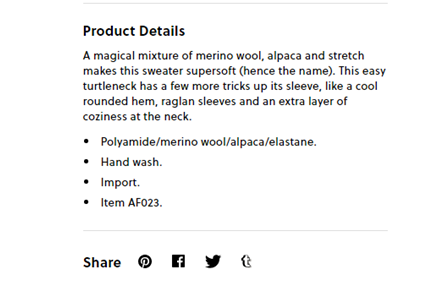
Phrases like ‘magical mixture’ and ‘tricks up its sleeve’, used to describe the super soft materials and the versatility of the sweater, make it seem logical to spend $95 without hesitation.
7. Optimise for Search Engines
I have been talking about the product page and descriptions all along, but that doesn’t mean you can ignore the SEO part. After all, you need to rank high on search engines, so that visitors can land on your webpages. So, optimise, optimise, and optimise!
Be mindful of the keywords you use as they aren’t only for customers but also for search engines. However, make sure that they reflect the searcher’s intent and are not stuffed in the content.
Also, long-tail keywords work better than short-tail ones as they are less competitive, especially if you are a small business. Google Keyword Planner, SEMrush and Ahrefs Keyword Explorer are some of the popular tools you can use to make keyword-research easy.
Now, where to place them? Most digital marketers say that it works best when you place keywords in product titles and bullet points in product descriptions.
Also, according to Spotify, using keywords in these places works the best:
- Page titles
- Meta descriptions
- Alt Tags
- Product descriptions (preferably in bullet points)
My opinion? Go for a combination of creative text with keywords somewhere in the title of the content, if you can add them. At last, you should go with whatever works best for you and your audience.
Bottom Line: It Is Contextual
Things that work for one might not work for everyone. So, with product descriptions, you need to find your tone and brand essence. And the best way to do that is by experimenting a bit.
The only points you need to keep in mind while trying your hand at something creative and exceptional are:
- Keep sentences short and on point.
- Make an emotional connection with your audience.
- Highlight the challenges and problems the product will solve for them.
- Let your content revolve around their pain points or needs and wants.
- Use positive words to evoke a sense of security and trust.
- Sell an entire lifestyle rather than just a product.
Share your knowledge. Tell stories. Explain the details. Delight your customers with sensory words and seductive descriptions. And wait for your compelling and persuasive product descriptions to give you impressive results.






